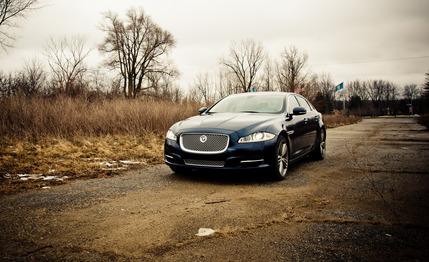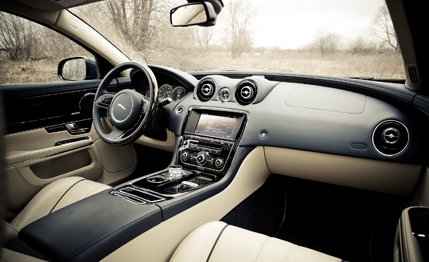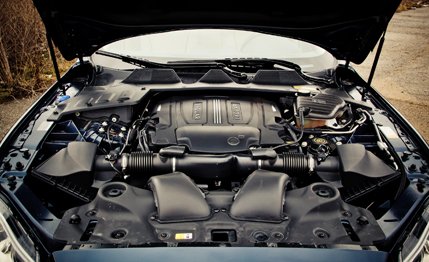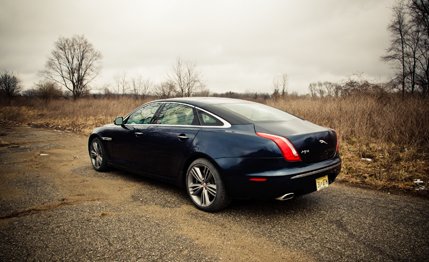
 Instrumented Test
Instrumented Test


If you’re looking at the Jaguar XJL Supersport with possible acquisition in mind, chances are pretty good that you have a little string of initials after your name, attesting to your economic status. Initials like CEO, or COO, or (most probably) CFO, for example. One glance at the price tells you this car isn’t exactly everyday transportation. Possession sops up mass quantities of disposable income, and it’s possible—likely, even—that if you have the wherewithal to seriously contemplate ownership, you may also be thinking about retaining a chauffeur.
That may be okay for trips to and from a corporate HQ in a heavy urban setting. The L (long-wheelbase) version of Jag’s revitalized XJ sedan adds about five inches to rear-seat legroom, so with the exception of headroom there’s plenty of space back there, as well as trays that drop down from the backs of the front seats. You can relax, check your email, text, contemplate documents, and plot corporate takeovers.
But trust us, you do not want to deprive yourself of piloting this superb conveyance. Although we should add this warning: The experience is seriously habit-forming.
Bureau of Statistics
As noted, the L stands for Long: That extra rear legroom translates to the wheelbase—which grows from 119.4 inches to 124.3—and an equal stretch overall, from 201.7 to 206.6. Width (74.6 inches) and height (57.0) are the same for long-wheelbase and standard XJs. Those dimensions are more or less in the middle of this Jag’s direct competitors, all of which have German accents—the long-wheelbase Audi A8, BMW 7-series, and Mercedes’ AMG S-class offerings, the S63 and S65.


This is a substantial car, and size inevitably adds up at the scales. Our test car weighed in at 4412 pounds (a standard-wheelbase XJ Supersport we tested weighed 4316 pounds). Though it’s no wraith, the big Jag is among the trimmest of these CEO sedans, some of which—we’re looking at you, Mercedes—make the scales creak at around 5000 pounds. Credit extensive use of aluminum in the XJ’s skin and chassis on this score.
Power Play
All members of the new XJ lineup share the same 5.0-liter V-8, offered in naturally aspirated (basic) and supercharged versions. There are two levels of the latter, and the most potent of them—510 hp, 461 lb-ft of torque—propels the Supersport edition. (Compare that to the Supercharged-badged car, which makes only 470 hp, and the naturally aspirated V-8’s 385 hp.)
The Jag’s six-speed automatic, and its gimmicky dial-a-mode shifter, is upstaged by the seven- and eight-speed autos offered by the Deutsche-mobiles. It allows manual shifting via the paddles that have become de rigeur in today’s performance automatics, but the shifts could be a bit quicker, and the Germans’ transmissions are smoother.
Nevertheless, when summoned to full thrust, the Jag’s supercharged V-8 delivers eye-opening sprints: 0 to 60 in 4.2 seconds, 0 to 100 in 9.6, 30 to 50 in 2.2, 50 to 70 in 2.7. As to the other supercharged XJs, a short-wheelbase Supersport hits 60 in 4.1 seconds, while an XJL Supercharged hits that mark in 4.4. Quick pretty well describes them all.
What’s the secret? The aforementioned low-for-its-class curb weight, for one. Rip-tide torque with a curve that resembles the topography of Nebraska—essentially flat from 2500 to 5500 rpm—for another. This delicious rush could easily induce the Little Old Lady from Pasadena syndrome: you can’t keep your foot off the accelerator. Hard to explain to cops.


You probably don't expect much in terms of fuel economy, and you shouldn't. The Supersport is rated for 15 mpg city, 21 highway. We logged 15.
Long on Agility
The Supersport can dance just as well as it sprints. A long wheelbase isn’t a particularly good starting point for eager transient response, but good weight distribution (51/49, front/rear), Jaguar’s active differential control, and the Supersport’s suspension tuning keep things lively. Add an exemplary steering system that’s both quick (2.7 turns lock-to-lock) and accurate, and you have a big car that drives a lot smaller than its mass and dimensions would lead you to expect, sharing more tactile information with the driver than most of the other cars in this class.
We must add that some of this information may not be entirely welcome in a big luxury sedan. The suspension tuning that reduces body roll to near-nil can also be a little abrupt on choppy surfaces. Also, given the car’s responses, we’re a little surprised that the Dunlop SP Sport Maxx GT tires (245/50ZR-20 front, 275/35ZR-20 rear) didn’t deliver a little better than 0.87 g on the skidpad. Moderate understeer is probably the skidpad culprit, although with the stability control switched off, it’s easy to get the rear end to step out.
The Dunlops certainly make the most of the Jag’s powerful braking system, however; it delivered a 70-to-0-mph stopping distance of 154 feet. That’s pretty close to sports-car performance and exceptional for a car weighing well over two tons.
Inside and Out
Whatever you might expect to find inside a car with a price tag approaching $120,000, it’s all here. Superb leather, of course, with piping highlights. A choice of several interior wood trim packages, including piano black, plus stainless steel highlights. Orchestral sound, via a Bowers & Wilkins 1200-watt, 20-speaker audio system. MP3, Bluetooth, and iPod connectivity. A vast swath of roof glass. Power-adjustable driver’s seat bolsters. Power-reclining rear seatbacks. Dual rear-seat DVD players.


A nav system also is standard, but it’s hard to love this particular unit, which seems to be a little behind the current state of the art, and defies quick programming. And it’s hard to love the virtual gauges, with their tiny increments—especially the speedo, which is reminiscent of the days when these instruments were mechanical, with jiggly needles and Smiths logos.
The Jag’s low cowl and thin roof pillars provide good sightlines in the front and in the rear quarters. However, the rear window is pinched a little, a tradeoff for the fast rear roofline.
One glance at the XJ’s supersonic teardrop profile says that this trade was a good one. Building on the new design language established by the XF, Jaguar’s top-of-the-line sedan is the personification of contemporary sleek, and stretching it by five inches only amplifies the look.
So, Mr. COO, there you have it. Sleek, powerful, agile, and elegant. Now, how about a part-time chauffeur’s position?